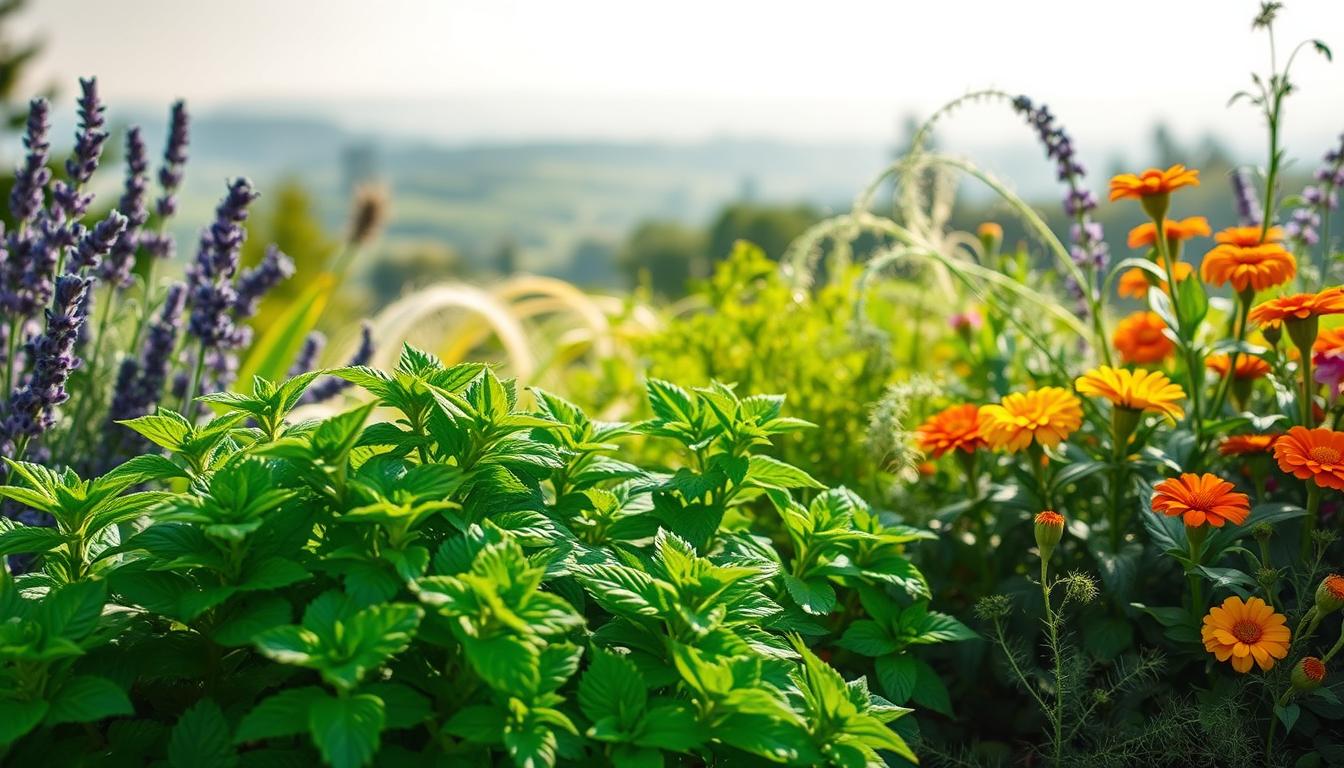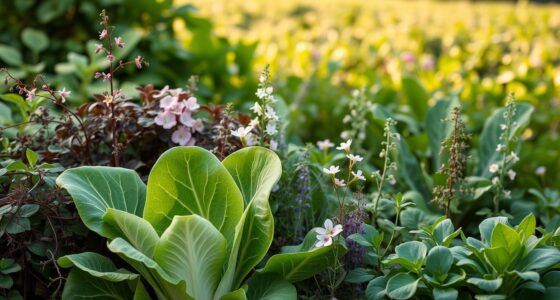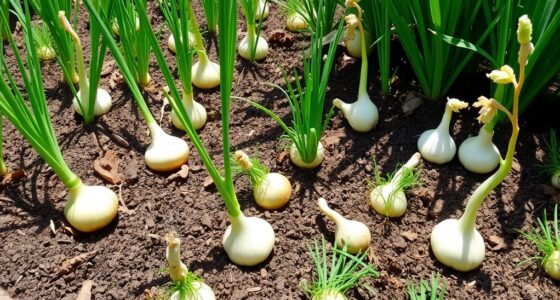Have you ever wandered into your garden, the fresh scent of mint wrapping around you like a warm embrace? It’s a feeling that brings a smile, a sense of peace amidst the hustle and bustle of life. The beauty of mint goes beyond its aromatic leaves; it’s a gateway to a thriving garden ecosystem. When considering companion plants for mint, you’re not just thinking about what to plant with mint. You’re embarking on a journey to harmonize your garden, making it a place where growth, flavor, and vibrancy flourish hand in hand. Strategically choosing the best plants to grow with mint can elevate your gardening experience, transforming your space into a lush paradise brimming with life and beauty.
In this article, you’ll discover not only the ideal matches for mint but also the magic that happens when these plants grow together. Get ready to explore the world of companion planting, where each herb, vegetable, and flower plays its unique part in nurturing a successful garden.
Key Takeaways
- Mint enhances the growth and flavor of companion plants.
- Choosing the right partner plants can improve pest control naturally.
- Mint’s aromatic qualities assist in attracting beneficial insects.
- Plants like basil, tomatoes, and oregano thrive alongside mint.
- Companion planting reduces competition for essential nutrients.
- A well-planned mint garden can boost both aesthetics and productivity.
Why Companion Planting Matters for Mint
Understanding why companion planting matters for mint can greatly enhance your gardening experience. By strategically combining mint with other plants, you can create a thriving ecosystem that promotes the health and flavor of your garden. This method increases not only the aesthetics of your space but also the overall productivity of your plants.
Benefits of Growing Mint with Others
Mint garden companions provide numerous advantages. When planted alongside compatible plants, mint serves as a natural pest deterrent. Its aromatic oils repel harmful pests while attracting beneficial insects that aid in pollination and pest control. Using this approach can significantly lower your reliance on chemical pesticides, which is better for both your garden and the environment.
Enhancing Growth and Flavor
Employing the benefits of growing mint with others extends beyond pest management. Mint improves soil health and nutrient uptake, which directly impacts the growth and flavor of surrounding plants. The synergy created through companion planting leads to robust plant development, allowing each species to thrive. You may notice richer flavors in your crops, making your culinary creations even more delightful.
Reducing Pests Naturally
Planting mint as a companion reduces pests naturally. The aroma emitted from mint can deter certain insects like aphids and spider mites, protecting both your mint and its neighbors. Pairing mint with plants susceptible to pests creates a barrier of protection, resulting in a more vibrant, healthier garden.

Best Companion Plants for Mint
When considering the best companion plants for mint, a few standout choices can significantly enhance your garden’s ecosystem. These plants not only complement each other’s growth but also contribute to a healthier environment. Through mint companion planting, you can create a vibrant habitat that maximizes the benefits of all plants involved.
Basil: A Flavorful Pairing
Basil makes an excellent addition to your mint plant pairings. Sharing similar growing conditions, basil thrives when grown alongside mint. The aromatic qualities of both herbs create a flavorful synergy, while basil benefits from the natural pest-repelling abilities of mint. This combination not only enhances your culinary options but also promotes healthier crops.
Tomatoes: A Perfect Match
Planting tomatoes near mint can provide great advantages. Mint’s strong aroma acts as a natural barrier against common pests such as aphids, helping to protect nearby tomato plants. This partnership can lead to a more fruitful tomato crop while ensuring that your garden remains vibrant and pest-free. Mint companion planting with tomatoes can yield delightful results in both flavor and yield.
Oregano: A Beneficial Buddy
Oregano pairs beautifully with mint and thrives in similar conditions. When grown together, they create an ideal herb garden environment. Oregano’s presence enhances the overall diversity of your mint plant pairings, supporting healthy growth while enriching the flavor profiles of your culinary creations. This pairing also encourages a balanced ecosystem, vital for maintaining a thriving garden.
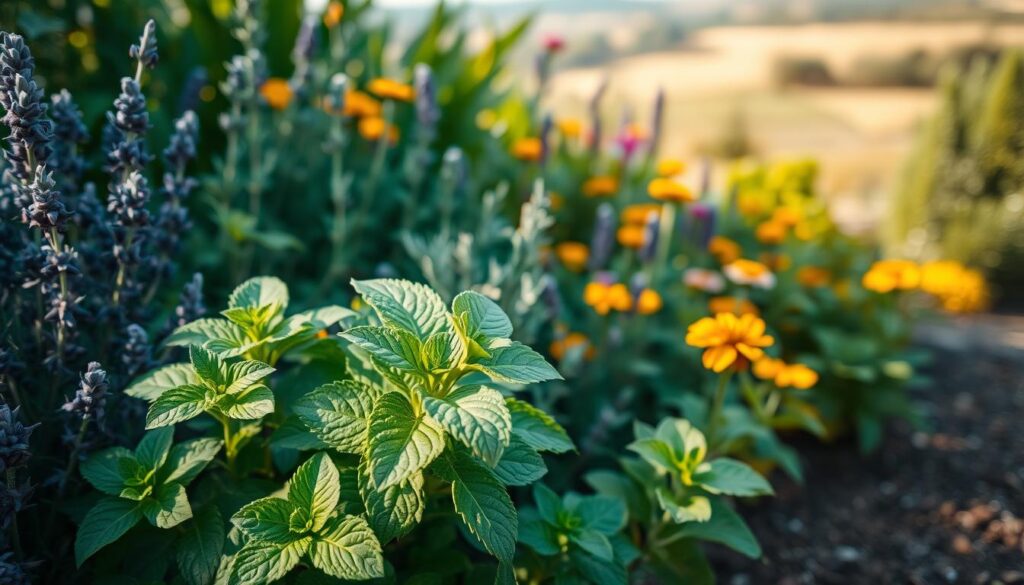
Herbs That Thrive with Mint
In the realm of mint companion planting, certain herbs stand out as ideal mint garden buddies. Growing these herbs alongside mint not only enhances their flavors but also fosters a healthy garden environment. Below are some herbs that grow well with mint, each bringing unique benefits to your garden.
Cilantro: Complementary Aromatics
Cilantro pairs beautifully with mint, enriching the aromatic profile of your garden. The fresh and zesty flavors of cilantro can elevate dishes, making it an attractive addition alongside your mint plants. This herb thrives in similar conditions, creating a lush and fragrant growing area.
Chives: Enhance the Taste
Chives are another fantastic option for mint companion planting. Their mild onion flavor complements the freshness of mint in culinary creations. Beyond flavor, chives can deter pests that often target mint, providing an extra layer of protection for both herbs in your garden.
Rosemary: A Robust Partner
Rosemary adds a strong scent that works well with mint, contributing to a unique garden atmosphere. This hardy herb not only thrives alongside mint but also acts as a natural pest repellent. The combination of rosemary and mint creates a visually appealing space while ensuring both herbs grow vigorously.
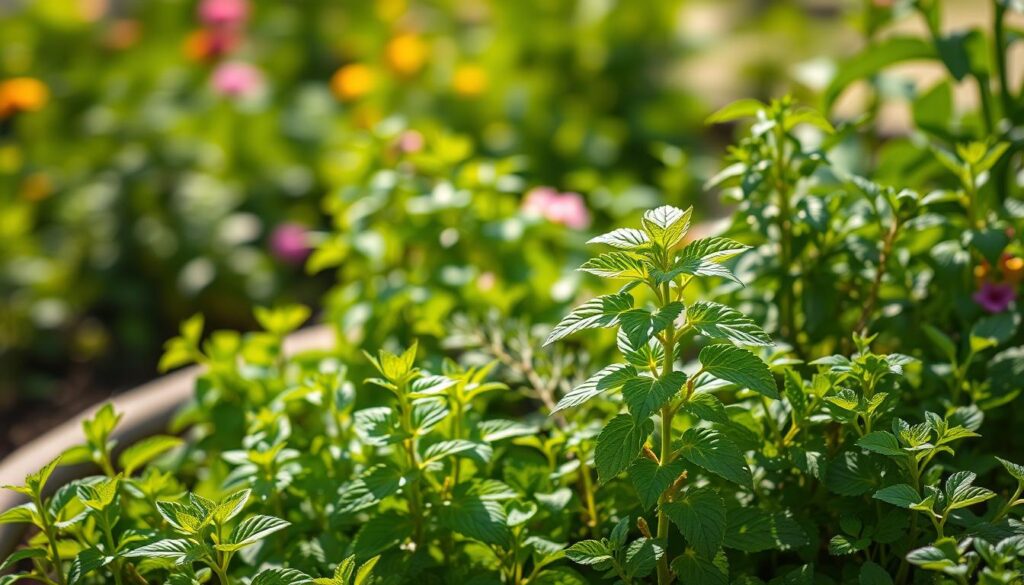
| Herb | Benefits | Growing Conditions |
|---|---|---|
| Cilantro | Enhances flavor, aromatic pair | Prefers well-drained soil, full sun |
| Chives | Deters pests, enhances taste | Well-drained soil, partial shade to full sun |
| Rosemary | Pest repellent, robust flavor | Drought-tolerant, prefers sandy soil, full sun |
Vegetables That Enjoy Mint’s Company
Creating a garden that includes vegetables that enjoy mint’s company can lead to thriving plants and delightful flavors. Mint acts as a companion to various vegetables, enhancing their growth and providing natural pest protection. Below are some vegetables that pair well with mint, showcasing the benefits of these mint garden companions.
Carrots: A Rooted Relationship
Carrots thrive in proximity to mint. The aromatic oils emitted by mint repel pests like the carrot root fly, making this partnership beneficial for both. This combination allows carrots to grow strong and healthy, producing an abundant harvest.
Peppers: Adding Spice
Mint serves a protective role for pepper plants, deterring aphids and other common pests. When planted together, these spices create a dynamic duo in your garden. This relationship not only encourages healthy growth but also enriches the flavor profiles of your dishes.
Cucumbers: Cooling Together
Cucumbers can flourish alongside mint, resulting in enhanced growth and a refreshing taste. The cooling nature of cucumbers blends harmoniously with mint’s strong aroma, making them perfect partners in your culinary creations. Enjoy the benefits of these plants that thrive alongside mint as they complement each other beautifully.
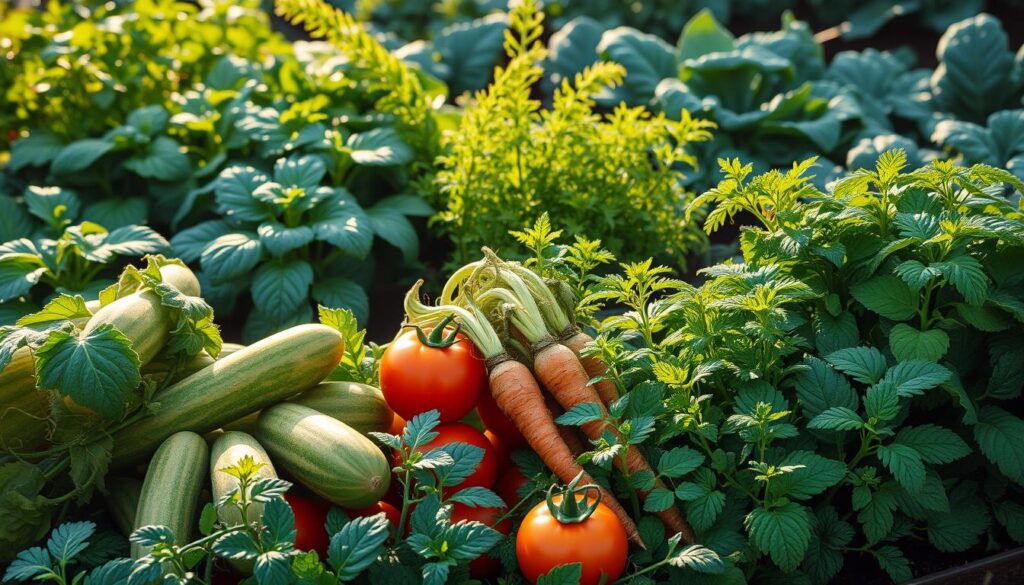
| Vegetable | Benefits of Growing with Mint |
|---|---|
| Carrots | Protection from carrot root fly; enhanced growth |
| Peppers | Deters aphids; promotes robust growth |
| Cucumbers | Improved growth; refreshing flavor combination |
Fruits That Pair Well with Mint
When thinking about the best fruits for your garden, consider how certain fruits that pair well with mint can not only enhance flavors but also improve overall growth. Mint plant pairings with fruits can create a delightful synergy in your garden. Let’s explore some fantastic choices.
Strawberries: Sweet and Refreshing
Strawberries thrive alongside mint due to the latter’s ability to repel pests. This natural pest control allows your strawberries to produce larger, sweeter fruit, making them a top choice among companion plants for mint. The aromatic leaves of mint complement the sweet fragrance of strawberries, creating an enticing garden atmosphere.
Melons: A Juicy Combo
Melons benefit from the lush greenery of mint, which serves as a supportive companion in the garden. As melons grow, the sprawling vines can enjoy the shade and moisture provided by mint. This mint plant pairing nurtures a healthier environment, leading to tastier, juicier melons ready to enjoy during hot summer days.
Citrus: Bright and Bold Flavors
Citrus plants gain from mint’s unique cooling properties while enjoying its pest deterrent capabilities. This companion plant for mint not only helps in reducing harmful insects but also enhances the flavors of citrus fruits. The refreshing taste of mint combined with zesty citrus creates a delightful burst of flavor that brightens up any dish.

Flowers That Flourish Alongside Mint
Incorporating flowers that flourish alongside mint not only enhances your garden’s aesthetic appeal but also contributes to the overall health of your mint plants. Companion planting with mint creates a more biodiverse environment that can deter pests, attract beneficial insects, and provide beautiful color to your garden. Here are some of the best options to consider:
Marigolds: Pest Deterrents
Marigolds are excellent mint garden companions, known for their ability to repel pests such as nematodes. Planting these vibrant flowers near your mint can create a protective barrier, ensuring that your mint thrives without being bothered by harmful insects.
Nasturtiums: Edible Flowers
Nasturtiums bring vibrant hues to your garden while serving as edible flowers. These beauties not only enhance your dishes with color but also attract pollinators. As you embrace companion planting with mint, nasturtiums will add a delightful flair to your garden while promoting biodiversity.
Lavender: A Scented Companion
Lavender stands out as a stunning and aromatic addition to your mint garden. It offers a pleasing scent and additional pest-repelling capabilities. Lavender lures pollinators, ensuring your garden remains lively and productive while providing an elegant touch to complement your mint plants.

| Flower | Benefits | Mint Companion Qualities |
|---|---|---|
| Marigolds | Pest deterrent, attracts beneficial insects | Protects against nematodes |
| Nasturtiums | Edible, brightly colored | Attracts pollinators |
| Lavender | Aromatic, pest-repelling | Lures pollinators |
Tips for Planting Mint with Others
When embarking on the journey of planting mint with others, several key considerations can help ensure a thriving garden. Understanding the proper spacing, soil requirements for mint, and watering needs is vital. These tips will guide you in creating an enjoyable and productive mint garden.
Spacing and Placement
Proper spacing is essential when planting mint alongside your garden buddies. Mint tends to spread vigorously, potentially overwhelming neighboring plants. Allow at least 18 to 24 inches between mint and other species. This will help maintain balance and harmony in your garden, letting each plant thrive without competition.
Soil Requirements and Preferences
Your soil choice plays a significant role in mint’s success. Mint flourishes in well-draining soil enriched with organic matter. Aim for a pH around 6 to 7. Mixing in compost can enhance soil quality and provide necessary nutrients. Following these soil requirements for mint sets the foundation for healthy growth.
Watering Needs
Mint prefers consistently moist soil, yet care should be taken to avoid overwatering, which can lead to root rot. Checking moisture levels regularly is important. A good practice is to add a layer of mulch around the plants to help maintain humidity and suppress weeds. This technique allows your mint garden buddies to coexist happily.
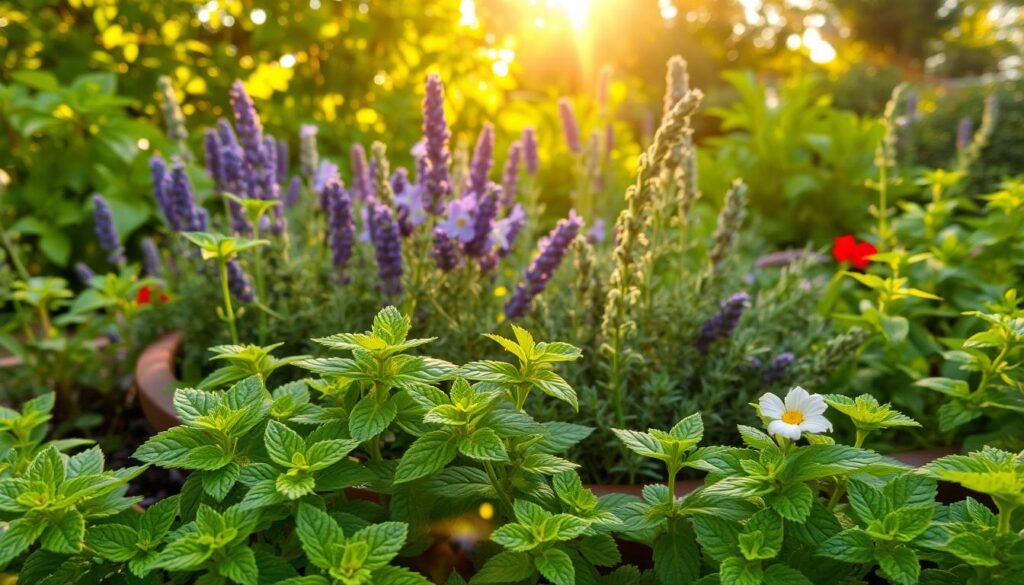
- Maintain at least 18-24 inches of space between mint and other plants.
- Opt for well-draining, nutrient-rich soil with a pH of 6-7.
- Keep the soil consistently moist, but do not let it sit in water.
Avoiding Plants That Don’t Cooperate with Mint
When growing mint, it’s essential to be aware of what not to plant with mint. Certain plants can hinder mint’s growth or suffer from its vigorous nature. By avoiding incompatible plants, you can foster a healthier garden where each species thrives without competition.
Plants to Keep Away
Certain herbs and flowers tend to clash with mint. Here are some prominent examples:
- Parsley: This herb competes for nutrients, leading to decline.
- Chamomile: Incompatible with mint’s rapid growth, it may not flourish.
- Fennel: Can overshadow mint, making it difficult for both to prosper.
- Thyme: Doesn’t handle the competition well, often showing stunted growth.
Signs of Incompatibility
Recognizing when plants that don’t cooperate with mint can save you time and resources. Look for the following signs:
- Stunted growth: A sure sign that plants may be competing for the same resources.
- Poor leaf quality: Dark or yellowing leaves can indicate stress from competition.
- Decreased flowering: Inconsistent blooms may suggest that space is insufficient for healthy growth.

Mint Care: Keeping Your Garden Thriving
Taking care of your mint plants requires attention to several key practices that ensure healthy and bountiful growth. By incorporating effective techniques like pruning and fertilizing, along with smart pest management for mint, you can cultivate a thriving garden.
Pruning and Harvesting Techniques
Regularly pruning mint plants encourages bushier growth and prevents them from becoming leggy. Aim to trim back about a third of the plant’s height, especially during the growing season. This not only shapes the plants but also promotes vigorous new growth. When harvesting, snip off the upper leaves and stems, avoiding the woody base to keep your mint flourishing.
Fertilizing for Optimal Growth
Fertilizing plays a crucial role in mint care. Use a balanced, organic fertilizer during the growing season to help your plants stay robust. Apply it according to package instructions, ensuring even distribution around the root zone. This provides essential nutrients that support optimal development and enhance the mint’s flavor profile.
Pest Management Strategies
Monitoring your mint plants for pests is vital. Common issues include aphids and spider mites. Employing pest management for mint entails utilizing organic solutions such as neem oil, which can effectively deter these pests without harming the plants. Regular inspections and proactive measures help maintain a healthy environment for your mint to thrive.

The Best Ways to Use Mint in Cooking
Mint adds a unique freshness and vibrancy to a variety of dishes. Whether sweet or savory, there are countless ways to use mint in cooking that can elevate your culinary creations. You can explore creative mint flavoring techniques to enhance your meals and beverages remarkably.
Flavoring Desserts and Drinks
Incorporating mint into desserts brings a refreshing twist. Consider adding fresh mint leaves to brownies, cakes, or even sorbets. Mint leaves can also transform drinks; mint-infused lemonade or mojitos offer a delightful, cooling sensation perfect for hot summer days.
Elevating Savory Dishes
When you think of cooking with mint, don’t overlook its ability to elevate savory dishes. Fresh mint can enhance the flavor profile of lamb, giving it a bright finish. Tossing mint into salads introduces an unexpected pop that can complement ingredients like cucumbers and tomatoes.
Infusing Oils and Sauces
For those skilled in mint flavoring techniques, infusing oils or creating mint sauces can add incredible depth to meals. A drizzle of mint-infused olive oil over roasted vegetables or a mint yogurt sauce for grilled meats enhances texture and flavor, showcasing the herb’s versatility.

Unique Mint Varieties for Your Garden
Exploring the world of unique mint varieties can bring new dimensions to your gardening experience. Each type of mint offers distinct flavors and aromas, enriching both culinary uses and the aesthetic appeal of your garden. Discovering different types of mint for gardening not only enhances taste but also diversifies your planting options.
Peppermint vs. Spearmint
Peppermint and spearmint stand out among mint plant varieties due to their unique flavor profiles. Peppermint, known for its strong menthol essence, is often utilized in teas, desserts, and candies. In contrast, spearmint presents a sweeter, milder taste, making it perfect for savory dishes and refreshing cocktails. Understanding their differences aids in choosing the right variety for your specific culinary needs.
Chocolate Mint: A Delightful Treat
Chocolate mint offers a delightful twist for those seeking unique mint varieties in their garden. With its distinct chocolatey aroma, it pairs wonderfully in desserts like brownies and ice creams. This variety adds not only flavor but also an enticing scent to your gardening space.
Apple Mint: A Fruity Twist
If you are looking for a fruity aroma and flavor, apple mint is a fantastic option. This type of mint for gardening produces a unique taste that elevates beverages such as teas and cocktails. Its refreshing scent can invigorate your garden, attracting pollinators who appreciate its delightful flowers.
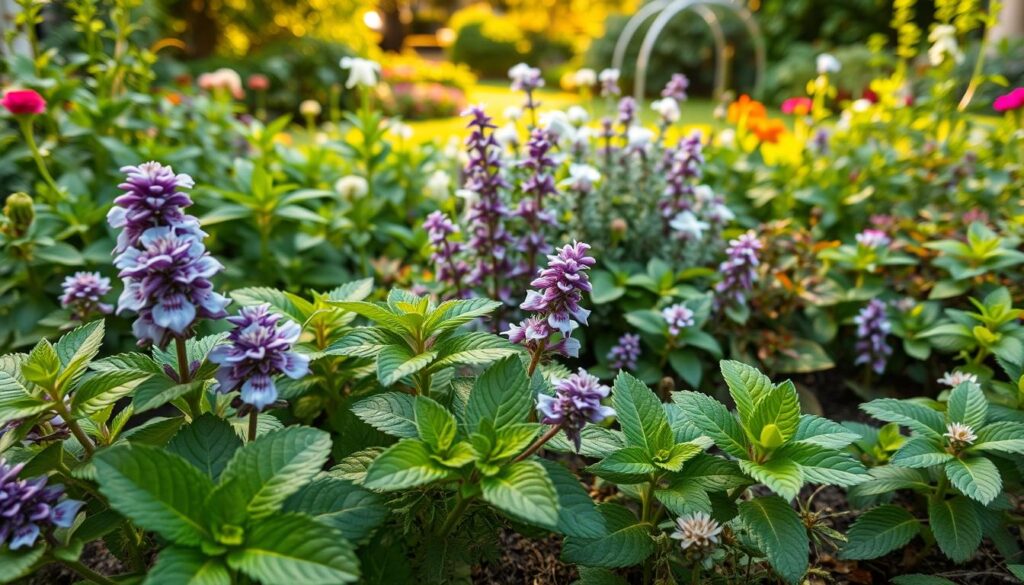
Seasonal Considerations for Growing Mint
Managing the seasonal planting of mint requires adapting to changing conditions throughout the year. Understanding different planting strategies will enhance your experience, from spring initialization to autumn preservation. Let’s explore how to effectively care for your mint during these varied seasons.
Spring Planting Tips
Beginning your mint journey in the spring enables robust root development. Select a spot with ample sunlight and prepare rich, well-draining soil for optimal growth. The soil temperature should be warm enough when considering seasonal planting of mint, usually between 60°F to 70°F. Regular watering is essential to support initial establishment. Fertilizing with a balanced mix during this stage can also promote healthy foliage.
Summer Maintenance Guidelines
During the summer months, maintain moisture levels as mint experiences significant growth. Consistent watering is crucial, particularly in hotter climates. Apply mulch to help retain soil moisture and minimize weeds. Watch for pests that may gather around your plants, as their activity increases during warmer weather. Following mint care guidelines ensures that your mint remains vibrant and aromatic throughout the summer.
Fall Harvesting and Storage Advice
As autumn approaches, be sure to harvest mint before frost sets in. This seasonal shift is crucial for retaining flavor. Gather the leaves for immediate use or consider drying them for future enjoyment. Freezing is another excellent method to preserve your crop, maintaining its potency for cooking and beverages. Learning about growing mint in different seasons enriches your gardening knowledge and enhances your culinary options.

| Season | Key Activities | Tips |
|---|---|---|
| Spring | Planting and Establishing Roots | Use rich soil, and ensure warmth. |
| Summer | Watering and Pest Monitoring | Apply mulch and check regularly for pests. |
| Fall | Harvesting and Preservation | Harvest before frost and consider drying or freezing. |
Mint as a Medicinal Herb
Mint is revered not just for its culinary applications but also for its rich medicinal heritage. The medicinal uses of mint have been documented throughout history, illustrating its effectiveness in treating a variety of ailments. You can find that these properties continue to resonate in modern wellness routines.
Traditional Uses in Herbal Remedies
Historically, mint has surfaced as a popular remedy for soothing digestive issues. This herb has been utilized to alleviate symptoms of nausea and indigestion. Additionally, it has served as a natural way to relieve headaches, contributing to its status as a versatile herbal option in traditional treatments.
Health Benefits You Should Know
Modern studies have highlighted numerous health benefits of mint. Beyond digestive support, mint exhibits anti-inflammatory properties that may aid in reducing overall inflammation in the body. Its aroma assists with respiratory relief, making it a go-to option for those facing congestion.
Incorporating Mint into Wellness Routines
Integrating mint into your mint wellness routines can be easy and enjoyable. From sipping hot herbal teas to using mint-infused essential oils, the versatility of this herb allows for a variety of approaches. You can enhance relaxation and elevate your health simply by incorporating this fragrant herb into your daily life.
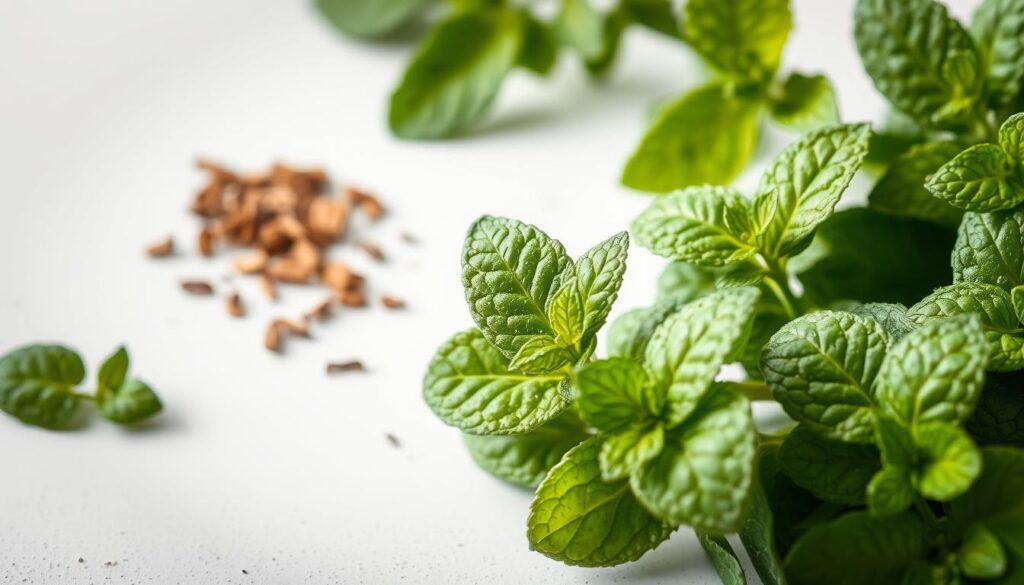
Creating a Mint-Centric Garden Design
A mint-centric garden design can transform your outdoor space into a vibrant haven. When you focus on designing with mint, you not only enhance the garden’s aesthetic but also enrich its functionality. By thoughtfully grouping mint with complementary plants, you create a lively tableau that draws the eye and invites exploration.
Designing with Mint in Mind
Incorporating mint into your garden involves careful planning. Consider arranging mint alongside other herbs and flowers that thrive together. This strategy promotes healthy growth and a bountiful harvest. Additionally, the fresh scent of mint can enhance the overall atmosphere, making your garden a delightful escape.
Focal Points and Visual Appeal
To make your garden stand out, create focal points using contrasting plants or colors. Bright blooms alongside lush green mint can add depth to the layout, inviting admiration. Experiment with plant height and texture to develop a dynamic landscape that captures attention and showcases your creativity.
Maximizing Small Spaces
For those with limited outdoor areas, there are effective ways to maximize small garden spaces while still incorporating mint. Vertical gardening techniques, such as wall planters or hanging pots, can elevate your mint plants and free up ground space. Container planting allows for flexibility, enabling you to manage mint’s vigorous growth while pairing it with other plants that complement your design vision.

Conclusion: The Joy of Growing Mint with Friends
Embracing the joy of growing mint is a delightful journey that transforms your garden into a vibrant space filled with aromatic wonders. Celebrating your herb garden allows you to experiment with various plants and discover unique combinations, enhancing not only your cooking but also your senses. Whether you’re sipping on a refreshing mint drink or enjoying a beautifully infused dish, the benefits of herb gardening come alive through each harvest.
Gardening with friends cultivates a sense of community, creativity, and shared experiences. As you plant and tend to your mint alongside companion plants, you’ll find endless opportunities to express your artistic flair. From arranging garden layouts to exploring diverse flavor pairings, engaging in this creative process broadens your horizons and connects you with nature.
When it’s time to share your harvest, the joy multiplies. Imagine gifting fresh mint sprigs or sharing homemade dishes infused with your vibrant yields at gatherings. This spirit of generosity not only enriches your culinary endeavors but also strengthens bonds with loved ones. So, gather your friends, roll up your sleeves, and relish in the excitement of the garden—where every leaf harvested symbolizes not just growth, but the joy of growing mint together.
